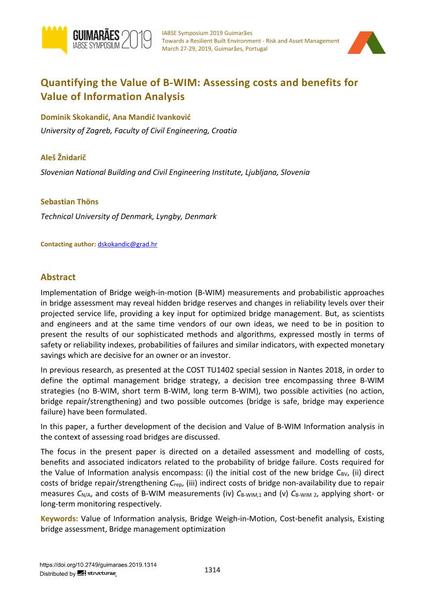Quantifying the Value of B-WIM: Assessing costs and benefits for Value of Information Analysis

|
|
|||||||||||
Bibliographic Details
| Author(s): |
Dominik Skokandić
(University of Zagreb, Faculty of Civil Engineering, Croatia)
Ana Mandić Ivanković Aleš Žnidarič (Slovenian National Building and Civil Engineering Institute, Ljubljana, Slovenia) Sebastian Thöns (Technical University of Denmark, Lyngby, Denmark) |
||||
|---|---|---|---|---|---|
| Medium: | conference paper | ||||
| Language(s): | English | ||||
| Conference: | IABSE Symposium: Towards a Resilient Built Environment Risk and Asset Management, Guimarães, Portugal, 27-29 March 2019 | ||||
| Published in: | IABSE Symposium Guimarães 2019 | ||||
|
|||||
| Page(s): | 1314-1321 | ||||
| Total no. of pages: | 8 | ||||
| DOI: | 10.2749/guimaraes.2019.1314 | ||||
| Abstract: |
Implementation of Bridge weigh-in-motion (B-WIM) measurements and probabilistic approaches in bridge assessment may reveal hidden bridge reserves and changes in reliability levels over their projected service life, providing a key input for optimized bridge management. But, as scientists and engineers and at the same time vendors of our own ideas, we need to be in position to present the results of our sophisticated methods and algorithms, expressed mostly in terms of safety or reliability indexes, probabilities of failures and similar indicators, with expected monetary savings which are decisive for an owner or an investor. In previous research, as presented at the COST TU1402 special session in Nantes 2018, in order to define the optimal management bridge strategy, a decision tree encompassing three B-WIM strategies (no B-WIM, short term B-WIM, long term B-WIM), two possible activities (no action, bridge repair/strengthening) and two possible outcomes (bridge is safe, bridge may experience failure) have been formulated. In this paper, a further development of the decision and Value of B-WIM Information analysis in the context of assessing road bridges are discussed. The focus in the present paper is directed on a detailed assessment and modelling of costs, benefits and associated indicators related to the probability of bridge failure. Costs required for the Value of Information analysis encompass: (i) the initial cost of the new bridge CBV, (ii) direct costs of bridge repair/strengtheningCrep, (iii) indirect costs of bridge non-availability due to repair measuresCN/A, and costs of B-WIM measurements (iv)CB-WIM,1 and (v)CB-WIM 2, applying short- or long-term monitoring respectively. |
||||
| Keywords: |
cost-benefit analysis bridge weigh-in-motion Value of Information analysis existing bridge assessment Bridge management optimization
|
||||
